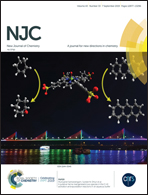Modifying the electronic and geometrical properties of mono/bi-layer graphite-like BC2N via alkali metal (Li, Na) adsorption and intercalation: computational approach†
Abstract
The boron/carbon/nitrogen-based materials have received much attention in condensed matter physics and material sciences due to their novel optoelectronic properties. Using first-principles calculations, we investigate the structural and electronic properties of Li and Na atoms intercalated onto the mono- and bilayer of BC2N sheets. The results show that both monolayer and bilayer BC2N exhibit nonmagnetic ground states with direct band gaps of 1.08 and 0.45 eV, respectively. The negative adsorption energies (in the range of ∼−0.76–−2.62 eV per atom) of 1L/2L-Mn©BC2N (M = Li, Na; n = 1, 2, 3) indicated that these structures are thermodynamically stable. The intercalation of Li and Na metal atoms into the bilayer BC2N is more favorable than the monolayer BC2N and also the Li intercalation is better than the Na intercalation. In the most stable configurations of Lin©BC2N, the metal atoms located on the center of the carbon hexagonal ring (H1 site) while for the Nan©BC2N, it prefers to locate above the C atoms or C–C bond. Based on the calculated electronic properties such as PDOS, planar average charge density difference and Bader charge analysis, it can be seen that the Li and Na alkali metals donate electrons to 1L/2L-BC2N sheets and 1L/2L-Mn©BC2N structures have metallic behavior. These findings suggest that the 1L/2L-Mn©BC2N structures are promising candidates for host materials with potential applications in nanoelectronics and energy storage.



 Please wait while we load your content...
Please wait while we load your content...